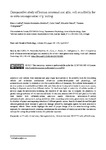Comparative Study of Human Neuronal and Glial Cell Sensitivity for in Vitro Neurogenotoxicity Testing

View/
Use this link to cite
http://hdl.handle.net/2183/39930
Except where otherwise noted, this item's license is described as Atribución-NoComercial-SinDerivadas 4.0 Internacional
Collections
- Investigación (FEDU) [938]
Metadata
Show full item recordTitle
Comparative Study of Human Neuronal and Glial Cell Sensitivity for in Vitro Neurogenotoxicity TestingAuthor(s)
Date
2017-02-03Citation
Laffon, B., Fernández-Bertólez, N., Costa, C., Pásaro, E., Valdiglesias, V., 2017. Comparative study of human neuronal and glial cell sensitivity for in vitro neurogenotoxicity testing. Food and Chemical Toxicology 102, 120–128. https://doi.org/10.1016/j.fct.2017.02.005
Abstract
[Abstract] Cell cultures from neuronal and glial origin have proven to be powerful tools for elucidating cellular and molecular mechanisms of nervous system development and physiology, and as neurotoxicity models to evaluate in vitro the possible effects of chemicals. But cellular heterogeneity of nervous system is considerable and these cells have been shown to respond diversely to neurotoxic insults, leading to disparate results from different studies. To shed more light on suitability of cellular models of nervous origin for neurotoxicity screening, the objective of this study was to compare the sensitivity to genetic damage induction of two nervous cell lines. To this aim, neurons (SH-SY5Y) and glial (A172) cells were treated with differently-acting genotoxic agents (bleomycin, actinomycin-D, methyl methanesulfonate, mitomycin C, and griseofulvin). After discarding cytotoxicity, genotoxicity was evaluated by a battery of assays encompassing detection of different genetic lesions. Results obtained showed that glial cells are generally more resistant to genotoxic damage induced by clastogenic agents, but more sensitive to aneugenic effects. These results highlight the need of proper design of in vitro neurotoxicology studies, especially for neurogenotoxicity screening, emphasizing the importance of employing more than one nervous cell type for testing the potential toxicity of a particular exposure.
Keywords
A172 cells
Comet assay
Neurogenotoxicity
Micronucleus test
SH-SY5Y cells
γH2AX assay
Comet assay
Neurogenotoxicity
Micronucleus test
SH-SY5Y cells
γH2AX assay
Description
This is an accepted version of the published document.
Editor version
Rights
Atribución-NoComercial-SinDerivadas 4.0 Internacional
ISSN
0278-6915






